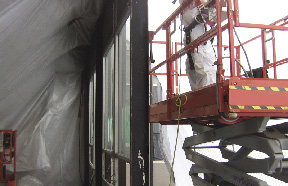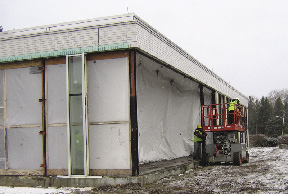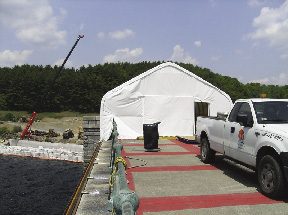PCBs (polychlorinated biphenyls) are man-made organic chemicals that were manufactured from 1929 to 1979, the year they were banned due to concerns that they cause serious health consequences.
PCBs are nonflammable and conduct heat without conducting electricity. Once known as a miracle chemical, they were acclaimed for preventing fires and explosions in electrical equipment. In fact, some safety codes once endorsed the use of PCBs as insulation in transformers and other electrical and lighting equipment.
PCBs were also used in a variety of building materials, such as caulk, grout, paint, adhesives, fiberglass and foam rubber insulation, and ceiling tiles. PCBs could also be found in roofing materials as well as HVAC gaskets and waterproofing materials.
Today, EPA regulations classify PCB building products containing greater than 50 parts per million as "unauthorized", making their continued use illegal. PCB-containing building products must be removed and disposed of as hazardous waste which adds to the cost of remediation. Because PCBs may also leach into surrounding materials, all building components that were in contact with the contaminated material may require removal, containment and/or restoration efforts. These remediation requirements, especially the removal of surrounding "contaminated" materials, can be costly and disruptive, especially for schools and other occupied buildings.
Regulatory requirements call for removal or encapsulation of all PCB-containing materials. Masonry, wood, or other building materials that come in contact with caulking will often become contaminated based on the porous nature of the material. Analyzing the extent of the contamination can often make a significant difference in removal or encapsulation effort and cost. Complete removal of a building's façade may be avoided by accurately determining the extent of PCB penetration, which can significantly reduce the cost of remediation. An experienced contractor may develop alternative work plans to remediate a building that still comply with regulatory guidelines while reducing costs and expediting the project schedule.
Another area of concern for PCB contamination is lighting fixtures, specifically ballasts of fluorescent lights. Given the widespread use of fluorescent lighting ballasts containing PCBs before the chemical was banned in 1979, schools, commercial/office buildings, and manufacturing facilities that have not had a complete lighting retrofit since then, most probably have ballasts containing PCBs. These ballasts may leak into the light fixture. Although intact, functioning ballasts do not pose any health threat, these lighting ballasts will all fail in time. For that reason, EPA recommends older PCB-containing lighting ballasts be removed.
As improper storage and/or disposal of PCB contaminated materials carry monetary penalties, it is important to have a qualified contractor, such as TMC Environmental handle the remediation and disposal of PCB contaminated waste. TMC Environmental has been serving clients across the northeast since 1995 and has a vast portfolio of successfully completed projects. Working with consultants, engineers, and property owners, TMC provides efficient and cost-effective, value-engineered solutions for sites impacted with PCBs, and other hazardous materials. Where there are PCB impacted building materials, there is often asbestos, and TMC possesses a unique ability to provide both asbestos and hazmat trained personnel to work on these and other complex project requirements.
Here are just a few examples of TMC's successful clean-ups:
1. In a multi-phase PCB remediation project, TMC performed more than $3,000,000 of remediation at the Wachusett Dam in Clinton, Mass. The top and the entire curved exterior granite face of the dam were impacted by PCB contaminated caulking. The project also involved the removal of mineral deposits, vegetation, and soil contaminated with PCBs. Utilizing innovative techniques and methodologies for containment and cleaning, TMC's team of experts was able to deliver substantial savings in cost and project duration through value-engineering solutions.
2. A Connecticut town acquired a property for back taxes with unknown PCB contamination. TMC decontaminated thousands of pounds of heavy equipment, machinery, and debris contaminated with TSCA PCBs from non-porous metals. Tons of TSCA PCB contaminated debris, soil, and non-TSCA PCB contaminated soil were transported and disposed off site. The scope of work also included the restoration of excavated areas.
3. Working at a former mint site, in full compliance with DEP and EPA regulations, TMC provided earth support/shoring, vibration monitoring, excavation, stockpiling, transportation, and disposal of chlorinated volatile organic compounds and non-TSCA PCB contaminated soils. To reduce project costs, TMC developed a strategic plan to perform the excavation of this material between existing structures in a surgical approach, limiting the disturbance to the surrounding buildings and soil.
4. TMC worked on a fast track schedule for a new building addition, to remove PCB and lead contaminated soil at a former salvage yard, before the onset of winter weather. The scope of services included pre-construction surveys, site layout, erosion control installation, and site preparation prior to strategic excavation of contaminated soil. The project required lead soil treatment/stabilization prior to the disposal of 1,200 tons of soil into a TSCA-approved landfill. In addition, TMC performed restoration activities that included backfilling and compaction for the new construction of a large addition to an existing structure.
With extensive PCB remediation experience and thorough regulatory knowledge, TMC Environmental stands out as the premier contractor for owners and consultants alike. Put TMC's expertise to work for you and/or your clients to resolve issues related to PCBs in building materials, electrical equipment, and soil.
TMC Environmental develops innovative solutions for clients facing complex environmental and industrial challenges. TMC offers 24-hour emergency response across the northeast and provides remediation and abatement, industrial, environmental construction, and waste management services to owners, general contractors, engineers, and municipal and government agencies. Uniquely staffed and equipped to deliver a one-stop solution for any environmental need, from inspection and analysis through project completion, TMC has rapid response service centers in CT, MA, NH, NY, and VT. PCB soil excavation











